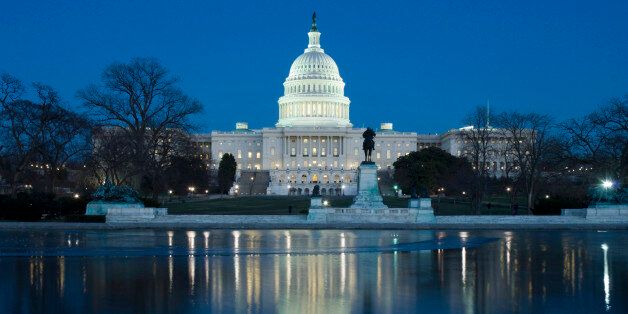
It is time to once again take a broad look at the upcoming Senate midterm elections. As always in non-presidential election years, I seldom pay much attention to the House races, for a number of reasons. First, there are a lot of them -- too many for one person to reasonably keep track of. Second, this year seems like a pretty foregone conclusion: the House will remain Republican, and the only two real questions are whether (and by how much) they will increase their lead, and how strong the Tea Party faction will be after the dust settles on election night.
The Senate, however, is much easier to keep tabs on, and is where a partisan power shift may happen. As always, my election predictions can be taken with the appropriate grain of salt, since while I do pay very close attention to the polling, in a lot of close races I tend to factor in a large portion of nothing short of gut feeling. Your gut may feel a different way, of course. Let me know your thoughts in the comments (it's a game the whole family can play!).
The current makeup of the Senate is 45 Republicans, 53 Democrats, and two Independents who caucus with the Democrats. For control to shift to the Republicans, they would have to pick up six seats (a 50-50 tie would go to the Democrats, with Vice President Biden casting the deciding vote). Earlier in the year, the punditocracy (and the wonkocracy, if I might coin a word for Nate Silver and his ilk) had all but decided that Republicans were a lock to take control. In recent weeks, however, many poll-watchers have begun predicting a much closer contest, and have seen signs of improving chances for Democrats to weather the storm. With all the recent news on the polling front, I thought it was time to make my own picks for the upcoming races.
Safe Republican
Listed in roughly west-to-east order (because I am looking at a map while composing this list), Republicans are the safe bet in the following states: Idaho, Montana, Wyoming, South Dakota, Nebraska, Oklahoma, Texas, Mississippi, Tennessee, Alabama, South Carolina, West Virginia, and Maine. This means a pickup of three seats: West Virginia, South Dakota, and Montana. Most poll-watchers have agreed from the beginning of the campaign that these three formerly-Democratic seats would fall to the GOP. Montana had a bit of drama when the Democratic candidate was forced out of the race when his past plagiarism was revealed, but the race didn't significantly change as a result.
Safe Democratic
Again, west-to-east, the following should be considered safe Democratic states this time around: Hawai'i, Oregon, New Mexico, Minnesota, Illinois, Michigan, Virginia, Delaware, New Jersey, Massachusetts, and Rhode Island. Net pickup is zero, as these are all current Democratic seats. Oregon was billed as a possible Republican pickup, but the candidate Republicans chose to take on Jeff Merkley has not gained any ground in the polling. Michigan was likewise eyed by Republicans, but they put up an incredibly weak and unprepared candidate, and the polling shows a clear Democratic edge.
Leaning Republican
Kentucky was seen as a possible pickup by Democrats, due to the weakness of Mitch McConnell among his constituents, but in the most recent polling, Alison Lundergan Grimes has fallen back a bit. This race could tighten up as we get closer to the election, but for now McConnell seems to have gained a clear edge.
Georgia was likewise seen as a possible pickup for Democrats, and the polling is tighter here than in Kentucky, so an argument could be made that this state is too close to call. For the moment, Republican David Perdue seems to have a very slight edge over Michelle Nunn.
Louisiana's polling is incredibly close as well, and many put the race in the too close to call category, but for the moment my gut is telling me this will likely be another Republican pickup. I could always be wrong, however.
Leaning Democratic
Polling in Alaska is always tough to do, meaning nobody really knows what is going to happen there until after the votes are counted. A few recent polls show the Republican challenger up over Democrat Mark Begich, but my gut tells me Begich will prevail in the end. Not sure why I feel more confident about this race than many others, to be completely honest.
Colorado, on the other hand, shows a clear (but slight) edge for Mark Udall, so the state has to be counted as leaning Democratic. Udall has maintained this slight edge for a while now, so he'll likely keep it right up to the election.
North Carolina is going to be a tight race, and the polling has flipped several times already. Currently, Kay Hagan holds the edge over Thom Tillis, and she could maintain her lead until the election. The state has to be seen as leaning Democratic right now, although it could quickly change.
New Hampshire is perhaps the strongest state for Democrats in this category, as Jeanne Shaheen has held a significant edge over the carpetbagging Scott Brown. One recent poll put Brown up, but it is likely nothing more than an outlier. Shaheen will likely keep her seat.
None of these four states is a certain bet, but Democrats will likely need to hold onto all of them if they have any hope of retaining control of the Senate. A loss in any of these states (they are all currently held by Democrats) would mean Democrats would need to pick up one of the longshots they're hoping for in order to keep Harry Reid in control.
Too Close To Call
This all adds up to the Republicans winning 48 seats, and the Democrats holding on to 49. What happens in the other three races could determine control of the Senate, to state the obvious.
In Arkansas, Democrat Mark Pryor is in the political fight of his life. Early polling showed him holding a lead, but the situation has flipped to where Tom Cotton now holds a very thin (but consistent) edge. While this race could still go either way, right now it looks like the Republicans have a good chance of grabbing this seat from the Democrats.
In Iowa, the race is even closer, which is pretty disheartening for Democrats, since it was supposed to be an easy victory for Bruce Braley (who is running for the seat Tom Harkin is vacating). However, Braley's campaign began with two major stumbles, and he has not quite recovered from them. Challenger Joni Ernst has kept pace with Braley in the polls, and the race is likely going to be one of the closest on election night. Braley has an excellent chance of pulling it out, though, so if there's any minor edge in this race, it likely goes to him. Even with this, though, the race could easily go either way.
The surprising turn of events in Kansas moved this Senate race from a pretty sure thing for Republicans to being a real race that Pat Roberts could lose. The late withdrawal of Democrat Chad Taylor from the race may still leave his name on the ballot (the issue is in court this week), but with Taylor out it clears the way for Independent Greg Orman to have a good shot at unseating Roberts. The first poll taken after the shakeup shows Orman beating Roberts, but not by much. Until some more polling appears, this race is too close to call, with a miniscule edge for Orman. Adding to the confusion is Orman's statement that he will caucus "with the majority party" in the Senate, without saying what he'll do if his vote actually creates a majority for one party or the other (which, as you can see, is a very possible outcome).
If Democrats manage to win all their "leaning" races and eke out a win in either Arkansas or Iowa, Kansas won't matter because Democrats will already have the 50 votes they need to hang onto their majority status. But if Republicans pick up both Arkansas and Iowa and also lose Kansas, we won't know which party will control the Senate for the next two years until Orman makes up his mind.
To sum up: the Senate races are about as close as they can be. When we get closer to the election, perhaps the picture will clear up a bit more, but for now it's anyone's guess what will happen.
Chris Weigant blogs at:
Follow Chris on Twitter: @ChrisWeigant
Become a fan of Chris on The Huffington Post
